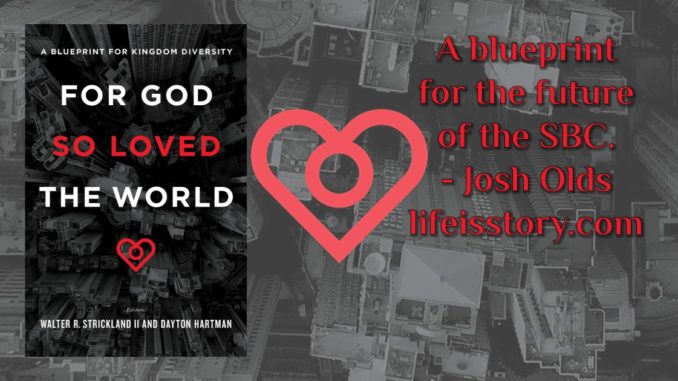
Published by B&H Academic on June 5, 2020
Genres: Academic
Buy on Amazon
Goodreads

Scripture captivates us by describing a people from “every nation, tribe, people, and language.” In pursuit of this kingdom vision, Christians have not always navigated America’s turbulent racial history in ways that honor others and glorify God. In For God So Loved the World, Dayton Hartman and Walter Strickland provide a blueprint for a better way, an invitation to Christ-centered diversity that is both descriptive and constructive.
Chapters in the book examine the historical context of the American church and its efforts to cultivate racial justice and unity, then present a unifying public theology, and practical guidance for the journey. Convicting and hopeful alike, For God So Loved the World motivates readers to seek reconciliation in light of biblical warrant, personal sanctification, and the church’s corporate witness.
One of the things that I’ve become more aware of in the past few years is that diversity and assimilation are not substitutes. Too many primarily white evangelical churches long for diversity, but what they mean by diversity is assimilation. They want minorities to come under the banner of white evangelical culture but never have the opportunity to change or affect that in any substantial way. As such, I’ve been seeking out resources for cultivating true diversity in the church and hoped that For God So Loved the World: A Blueprint for Kingdom Diversity would fit the bill.
Before I even began, I wanted to see what sort of diversity was represented in the group of authors collected for this book. And even though all of the individual authors are very tightly connected in the world of the Southern Baptist Church (to be expected as the publisher of this book is associated with the SBC), there is a reasonable diversity of race and gender. In other words, For God So Loved the World at least superficially practices what it preaches by giving space to minority voices within a denomination whose leadership is overwhelmingly white and male. But do they do so substantively?
The first part of the book sets the historical context. Dayton Hartman makes the case that the current absence of non-Western voices in “dominant culture” Christianity is due to the philosophical split of the East-West schism, the Reformation’s link to the Western church but not the Eastern, and the rise of colonialism. While that’s all true, I think more work could have been done to trace why these historical factors of 1000, 500, and 200 years ago still have significant impact on lack of diversity today. In other words, understanding this context explains then, but what about now. Harris’s follow-up chapter on segregation explains some of this, but doesn’t go as far as I would like it talking about the complicity of the Southern Baptist Church (whose origins are rooted in slave-holding) in perpetuating racial inequality. Fortunately, Harper’s chapter immediately after does deal with some of this and openly admits the failings of the SBC, but again serves too much as an apologist of the past instead of clearly saying “We were wrong.”
The second part of the book develops a public theology. In this section, authors tackle the topics of being pro-life and pro-immigrant while engaging other world religions in robust apologetics. Ashford’s chapter on being pro-life moves from abortion to racial cleansings to slavery, but never really talks substantively about any of it—and excludes discussion of police brutality, access to healthcare, mass incarceration, capital punishment, and other distinctly pro-life issues. Cross’s chapter on welcoming the immigrant is exactly what the church needs and is probably the strongest essay in the book. The SBC has a long way to go in working it out, but Cross provides them an ample blueprint for success. Horton’s chapter on apologetics is solid but is structured differently in layout and tone than the rest of the essays. It stands alone as a counter to other religions that are engaging African-Americans, such as Black Hebrew Israelites, Moorish Science Temple, Islam, and so on. It’s a good chapter, but doesn’t integrate as much with the larger work.
The last part of the book is about putting theology into practice. Williamson pens a chapter on racial reconciliation using Acts 16:16-40 as his theological background. The result is a fairly solid treatise on reconciliation that will still appeal to the average white evangelical. Bowen’s chapter on women in ministry is a good look at how women can function in leadership within the complementarianism of the SBC. Strickland’s essay on teaching Scripture is reasonable. And the rest of the section is pretty much devoted to practical outworkings of diversity within the SBC model of ministry.
Overall, For God So Loved the World achieves its goal of Kingdom diversity in this book. I wish they had condemned their racist past (and present) more strongly. I wish they had committed to a fuller inclusion of women in positions of leadership. I wish they had included more non-Black minority voices (one page from Daniel Im is not enough). But, quite frankly, this book is perfect for the SBC community that is primarily white, whose leadership is primarily male, and whose church has tended to assimilation over diversity. This is a great blueprint for the future of the SBC and while I don’t agree with every SBC doctrine (despite my time at an SBC seminary), I can recognize the desire for growth and change and am encouraged by the this book and the authors who contributed to it.
